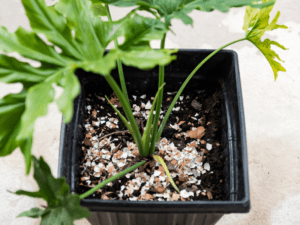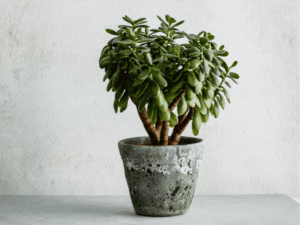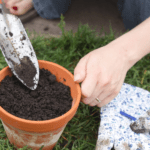Black rose succulents are captivating plants known for their unique and mesmerizing beauty.
These succulents stand out from others with their dark-hued petals closely resembling the appearance of black roses.
The black rose succulent’s allure lies not only in its aesthetics but also in its ability to thrive in various environmental conditions with minimal care requirements.
This makes it an ideal choice for both beginner and experienced gardeners seeking a visually stunning and low-maintenance plant.
Their striking appearance is not limited to their black coloration, but also to their unique rosette shape.
The tightly packed petals form a beautiful circular pattern, resembling a rose in full bloom.
This distinct feature further enhances the allure of the black rose succulent and makes it a focal point in any garden arrangement or indoor display.
Get ready to uncover the secrets of these stunning succulents!
The uniqueness and beauty of black rose succulents

Black rose succulents, scientifically referred to as Aeonium ‘Zwartkop’, are named after their striking dark purple or black foliage, resembling the petals of a rose.
They are believed to originate from the Canary Islands.
Their common names include Black Beauty, Black Prince, and Black Rose.
They feature thick, fleshy leaves that are arranged in a rosette shape, giving them an attractive and symmetrical look.
This succulent is known for its compact size and ability to thrive in arid conditions.
RELATED: 13 Unique Tall Succulents To Take Your Garden To New Heights
Life Cycle Of The Black Rose Succulent
The life cycle of black rose succulents involves dormancy during colder months and active growth during warmer seasons.
The flowers attract pollinators, which play a vital role in fertilization and seed production.
As the flowers wither after pollination, seed pods develop and eventually release the next generation of black rose succulents.
One fascinating detail about the life cycle of black rose succulents is their ability to go dormant during cold temperatures.
This allows them to survive harsh winters and resume growth when conditions become favorable again.
During dormancy, their above-ground parts may appear shriveled or wilted, but the plants are still alive beneath the surface.
As spring arrives and temperatures rise, these resilient plants awaken from dormancy and start their vibrant growth once more.
Black Rose Succulent Care
Watering requirements for the black rose succulent
Black rose succulents require infrequent watering due to their water-storing capacity. It is advisable to water them sparingly, allowing the soil to dry out between watering sessions.
When watering black rose succulents, it is important to follow a “soak and dry” method. This means thoroughly wetting the soil and then waiting until it completely dries out before watering again.
Overwatering can lead to root rot and other issues for black rose succulents. It is crucial not to let the plant sit in standing water or have excessive moisture in its potting mix.
During hot summer months, they may require slightly more frequent watering, while in colder winter months, they should be watered less often.
Light requirements for optimal growth
Black rose succulents thrive in bright, indirect light. They can be kept as either outdoor or indoor plants.
Sufficient sunlight is needed to support their metabolic processes and photosynthesis.
However, direct sunlight can be too intense and cause damage to the leaves. It is best to provide filtered or diffused light to avoid scorching.
They need around 6-8 hours of light per day for optimal growth. This enables them to carry out essential processes like nutrient absorption and water regulation efficiently.
Too little light can lead to weak, elongated growth, while excessive exposure can result in sunburned leaves.
Placing them near south-facing windows or using full-spectrum LED lights can help achieve the ideal lighting conditions for optimal growth.
Temperature tolerance and overwintering tips
Black rose succulents exhibit a remarkable tolerance to varying temperatures and possess unique characteristics that allow them to survive cold winters.
Here are some tips for ensuring their successful overwintering:
- Place black rose succulents in a location that receives full sunlight during the day.
- During the winter months, it is important to monitor the temperature and protect the plants from freezing by providing a suitable protective covering such as burlap or frost blankets.
- Black rose succulents should be watered sparingly during the winter season, allowing the soil to dry out between waterings to prevent root rot caused by excess moisture.
- To prepare black rose succulents for overwintering, it is recommended to reduce watering gradually starting in fall, as this will help them enter a state of dormancy.
Consider using a portable greenhouse or bringing potted black rose succulents indoors during particularly harsh winter conditions to provide added protection.
Soil preferences
The ideal potting mix for black rose succulents should be well-draining, allowing excess water to escape easily. It should also provide adequate air circulation to prevent root rot.
A combination of sandy loam soil, perlite, and peat moss is recommended as it offers the right balance of moisture retention and drainage.
Adding organic matter such as compost or aged manure can enhance soil fertility and promote healthy growth.
Choosing a container with drainage holes is crucial to prevent waterlogged soil, which can harm black rose succulents.
When repotting or transplanting these plants, gently remove any old or compacted soil from the roots while being careful not to damage them.
Use the recommended potting mix and ensure that the plant is positioned at the same depth as before.
Propagation methods for the black rose succulent

The black rose succulent can be propagated using various methods to ensure its successful growth and reproduction.
Here is a step-by-step guide on how to propagate the black rose succulent:
- Leaf Cutting: Take a healthy leaf from an established plant and allow it to dry for a few days until the callus forms at the base. Place the callused end into well-draining soil, ensuring that it is upright, and lightly water it. Keep the soil moist but not overly wet, and roots will start forming in a few weeks.
- Stem Cutting: Choose a stem that is healthy and at least 4-6 inches long. Remove any lower leaves, leaving only a couple near the top. Let the cutting dry for a day or two before planting it in well-draining soil, burying about an inch of the stem. Water lightly and keep the soil consistently moist until new growth emerges.
- Division: Carefully remove the black rose succulent from its pot and gently separate any offshoots or clusters that have formed around the main plant. Ensure each division has roots intact and plant them in individual pots with well-draining soil. Water sparingly until new growth appears.
- Seed Propagation: Collect mature seeds from the black rose succulent when they turn brown and dry. Sow them in a well-draining seed-starting mix, covering them lightly with soil or perlite. Keep the soil consistently moist but not soggy, and place the pots in bright indirect light or under grow lights. Germination may take several weeks to months.
Blooming period of the black rose succulent
Black rose succulents typically bloom during specific seasons, showcasing their striking dark-colored flowers.
During the blooming period, the black rose succulent produces stunning flowers that are known for their deep shades of red or purple.
These blooms can last for several weeks, adding a pop of color and elegance to the overall appearance of the plant.
It is important to note that the blooming period may vary depending on factors such as environmental conditions and proper care.
Conclusion
Black rose succulents are a beautiful addition to any garden, but it’s important to provide them with the proper care they need.
To enjoy their beauty, ensure that they receive adequate sunlight, well-drained soil, and occasional watering.
Protect them from extreme temperatures and provide sufficient space for growth.
Keep in mind these essential care tips for black rose succulents and revel in their stunning beauty.
FAQs
How often should I water my black rose succulent?
The black rose succulent should only be watered when the soil is dry. Overwatering can lead to root rot, so it’s important not to water it too frequently.
What is the ideal light condition for black rose succulents?
Black rose succulents need plenty of sunlight and prefer full sun to partial shade. They require about six hours of direct sunlight for proper growth and to maintain their dark coloration.
Can I grow black rose succulents indoors?
Yes, you can grow black rose succulents indoors. They will do best if placed in a south- or west-facing window where they can receive a lot of sunlight. Alternatively, you can use grow lights to provide adequate light.
What temperature range do black rose succulents prefer?
Black rose succulents tolerate temperatures down to 30 degrees Fahrenheit, but they prefer temperatures between 70-85 degrees Fahrenheit. They should be brought indoors if the temperature drops below freezing.
How do I prevent my black rose succulent from getting sunburned?
To prevent sunburn, you can acclimate your black rose succulent gradually by placing it in a spot with morning sun or filtered light. If there is a heatwave, move it to a shadier location to protect it from excessive sunlight.







